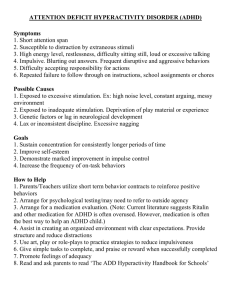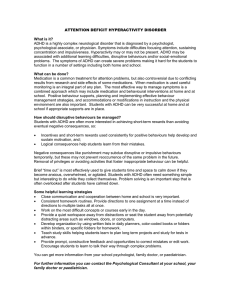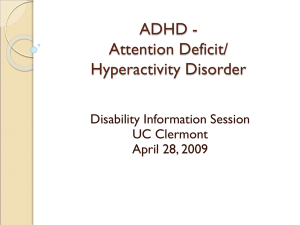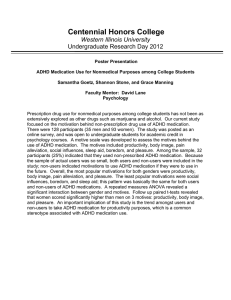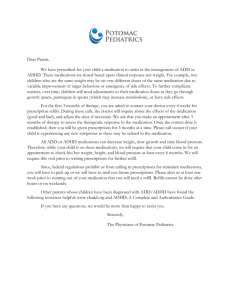Draft attention cluster guide
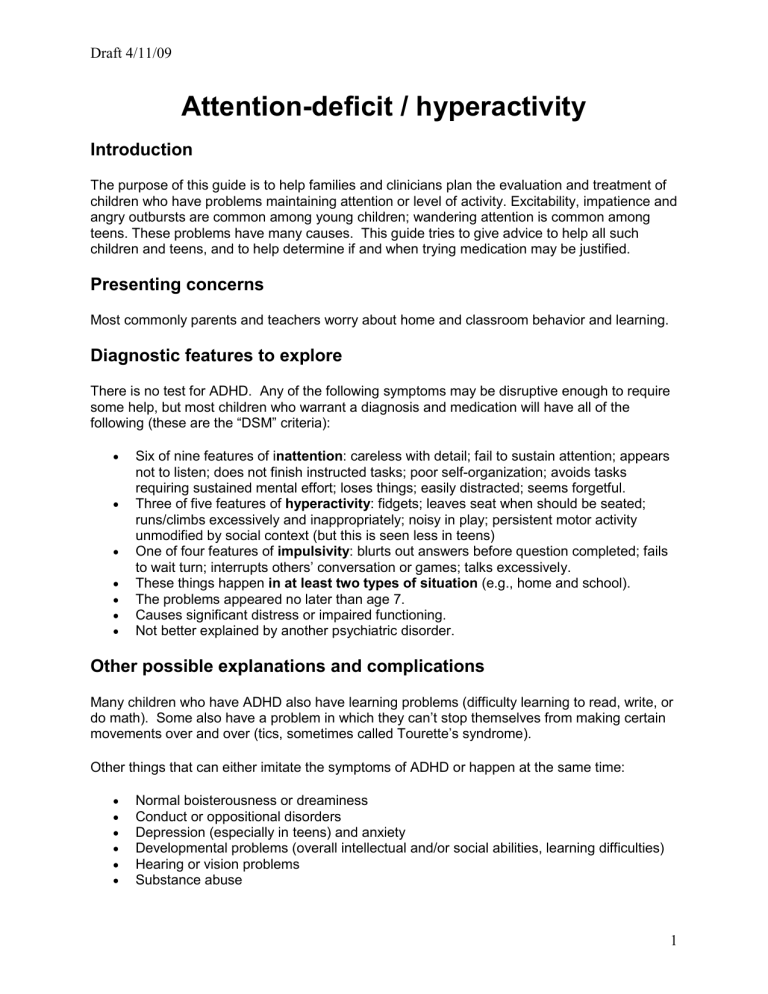
Draft 4/11/09
Attention-deficit / hyperactivity
Introduction
The purpose of this guide is to help families and clinicians plan the evaluation and treatment of children who have problems maintaining attention or level of activity. Excitability, impatience and angry outbursts are common among young children; wandering attention is common among teens. These problems have many causes. This guide tries to give advice to help all such children and teens, and to help determine if and when trying medication may be justified.
Presenting concerns
Most commonly parents and teachers worry about home and classroom behavior and learning.
Diagnostic features to explore
There is no test for ADHD. Any of the following symptoms may be disruptive enough to require some help, but most children who warrant a diagnosis and medication will have all of the following (these are the “DSM” criteria):
Six of nine features of i nattention : careless with detail; fail to sustain attention; appears not to listen; does not finish instructed tasks; poor self-organization; avoids tasks requiring sustained mental effort; loses things; easily distracted; seems forgetful.
Three of five features of hyperactivity : fidgets; leaves seat when should be seated; runs/climbs excessively and inappropriately; noisy in play; persistent motor activity unmodified by social context (but this is seen less in teens)
One of four features of impulsivity : blurts out answers before question completed; fails to wait turn; interrupts others’ conversation or games; talks excessively.
These things happen in at least two types of situation (e.g., home and school).
The problems appeared no later than age 7.
Causes significant distress or impaired functioning.
Not better explained by another psychiatric disorder.
Other possible explanations and complications
Many children who have ADHD also have learning problems (difficulty learning to read, write, or do math). Some also have a problem in which they can’t stop themselves from making certain movements over and over (tics, sometimes called Tourette’s syndrome).
Other things that can either imitate the symptoms of ADHD or happen at the same time:
Normal boisterousness or dreaminess
Conduct or oppositional disorders
Depression (especially in teens) and anxiety
Developmental problems (overall intellectual and/or social abilities, learning difficulties)
Hearing or vision problems
Substance abuse
1
Draft 4/11/09
General management and advice to child/teen and family
This is likely to be a long-term issue. This means that there will need to be ongoing monitoring of the success of treatment and periodic adjustments. It is not uncommon for treatment to be successful for a period and then seem to lose effectiveness.
Standardized checklists can be helpful for increasing the certainty of diagnosis and monitoring the process and side effects of treatment. The Vanderbilt ADHD scales
(parent and teacher; attached ) are readily available.
Although psychosocial treatment is considered helpful, medication is considered a mainstay of effective treatment for children thought to truly have ADHD (see below).
Basic parent/home approaches
Consider the environment o As much as is possible, maintain consistency and structure: routines, stated expectations of behavior, family rules. o Set realistic expectations, short-term goals, and praise success. Encourage the child to build on areas of strength. o Ensure the child has adequate sleep. o Allowing the child to race around in an ungoverned way in an attempt to diminish hyperactivity will not work. In contrast structured exercise might be helpful, particularly in improving sleep. o Be aware of other sources of stress on family members – if they have problems with mood or irritability, this will make it harder to moderate the child’s behavior.
Working with the school o Establish constructive three-way (parent, teacher, pediatric) communication with the school o Obtain consent for the primary care clinician to exchange information with the child’s teacher – make sure that basic hearing and vision testing has been done o Ask if testing has been requested and taken place to detect special educational needs
– think particularly of language and reading delays o Monitor progress (particularly if the child is on medication). o Classroom strategies that can help include: o o o o
Having the child sit at the front of the class
Giving extra time to stay organized (write down assignments, make sure that all needed materials are taken home or gathered for a project, have the child repeat back what he or she is to do)
Break longer assignments into shorter pieces
Coordinate reports of behavior with home – consider a daily report card of behavior and subsequent rewards or consequences.
2
Draft 4/11/09
Most commonly-used elements of evidence-based psychosocial interventions of ADHD
(adapted from Hawaii Evidence-based services committee report, 2004, and AAP Clinical
Practice Guidelines, Pediatrics, 2001;108:1044-44.)
Intervention strategy
Tangible rewards
Parent praise
Parent monitoring
Time out
Commands/limit setting
Description/rationale
Rewards or privileges contingent on performance of routine tasks
Conscious effort for parent to identify and comment on positive aspects of child’s behavior
Use of some systematic means to rate the child’s burden of specific ADHD symptoms and overall social, emotional, and academic function
Avoiding re-enforcement of undesired behavior through arguing or allowing the behavior to continue
Use of clear, simple commands that ideally give child a warning of impending expected behavior, an opportunity to perform it, a warning of consequences for non-performance, and a consistent consequence.
Example
Television or computer time contingent on attaining realistic goal
Complement child, especially when desired action is spontaneous
Use of the Vanderbilt scales or a customized checklist on a weekly basis, often in conjunction with simultaneous teacher ratings.
Child is required to sit without attention or activity for a brief period as a consequence for an undesired behavior
You can do one more puzzle and then we have to go. Now it’s time to go. If you don’t put the puzzle away now you can’t chose the tape we hear in the car.
Medication
Sources for medication planning o The American Academy of Child and Adolescent Psychiatry’s “Pocket Card” for
ADHD ( www.myguidelinescenter.com
) o The Stimulant Medication Management Information developed by the American
Academy of Pediatrics and the National Initiative for Children’s Healthcare
Quality ( attached ).
Primary care tasks typically include the following: o Initial prescribing o Adjusting doses o Monitoring for adverse effects (see AAP/NICHQ Management Information) including checking height and weight. Other side effects that may occur include headache and stomach ache, trouble falling asleep, irritability as the medicine
3
Draft 4/11/09 wears off, feeling dulled, shakiness, feeling, seeing or hearing things that others can’t see or hear, new appearance or worsening of tics.
o Encouraging child’s positive view of treatment
On-going evaluation and referral
The diagnosis can often be difficult, especially for young children and teens newly thought to have attention problems. Consider referral to a mental health specialist or developmental pediatrician if:
The diagnosis seems well-founded but there are contraindications to the use of stimulants (tics, hypertension, existing concerns about growth)
Problems with mood, behavior, or development seem more prominent than difficulties with attention or activity level
Initial response to treatment is poor or side effects develop to medication
The child’s problems are occurring in the context of other family emotional or behavioral problems
Consider referral for independent educational or psychological testing if:
There are insurmountable delays in obtaining evaluation through the school
Results from school testing for learning problems seem discrepant from screening evaluations in the pediatric office
There is concern for developmental delay
Resources
CHADD (Children and Adults with ADHD) http://www.chadd.org
.
Parents may need help advocating for adequate evaluation and help in their child’s school. The website, www.disabilityinfo.gov
, has links to general information about disabilities programs and rights in the US and on a state-by-state basis.
Materials from the AAP/NICHQ toolkit for ADHD can be viewed and downloaded from http://www.nichq.org/NICHQ/Topics/ChronicConditions/ADHD/Tools/
Bright Futures in Practice: Mental Health. Volume 1, Practice Guide, page 203.
Acknowledgments:
The concept, general outline, and some content of this handout have been adapted from the
WHO Guide to Mental and Neurological Health in Primary Care. More about the Guide can be found at http://www.mentalneurologicalprimarycare.org
This is a draft version of the handout for teaching and demonstration purposes (4/11/09).
Development of this handout was made possible as part of the research project, RO1 MH6269,
Mental health communication skills in pediatric primary care, funded by the National Institute of
4
Draft 4/11/09
Mental Health. For information: Larry Wissow, MD MPH, Johns Hopkins Bloomberg School of
Public Health, 703 N. Broadway Baltimore, MD 21205. 410-614-1243; Lwissow@jhsph.edu.
5

